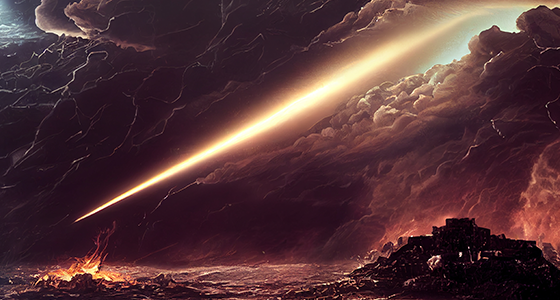Archaeological Evidence and the Obliteration of Sodom

Then the Lord rained on Sodom and Gomorrah brimstone and fire from the Lord out of heaven . . . and lo, the smoke of the land went up like the smoke of a furnace. —Genesis 19:24,28
Prior to the last fifteen years or so, the leading archaeological theory, for those who believe that Sodom and Gomorrah existed, placed the location of these cities on the south end of the Dead Sea, on the eastern shore—although there were several prominent advocates among archaeologists as far back as the nineteenth century for a northeastern shore location, and this was, in fact, the consensus location from the fourth century until the early 1900s.
The buzz and fun discussion currently taking place is largely the result of the Tall el-Hammam excavations in Jordan, led (beginning in 2006) by archaeologist Steven Collins, dean and professor at Trinity Southwest University. He has written voluminously and passionately about his positions.
Brian Nixon, of Assist News Service, quotes Collins, summarizing some of the findings of the dig in the year 2010:
"To start with, the Tall el-Hammam site has twenty-five geographical indicators that align with the description in Genesis. Compare this with something well known—like Jerusalem—that has only sixteen. Other sites have only five or six. So this site has a greater number of indicators than any other Old Testament site. That is truly amazing."
"Second, our findings—pottery, architecture, and destruction layers—fit the timeframe profile. Meaning we should expect to find items like what we are finding from the Middle Bronze Age. This is exactly what we are uncovering."
"Though . . . much research still needs to be conducted, I feel that the evidence for this being the ancient city of Sodom is increasing by the day."
Collins has provided extensive argumentation for a chronology of the Tall el-Hammam/Sodom archaeological site. His analysis nicely lines up with our proposed dates of Abraham, and he estimated that Sodom was destroyed “between 1750 and 1650” B.C.
Interestingly, if Tall el-Hammam is Sodom as I think the geographical and archaeological evidence categorically confirms, then it constitutes a most remarkable confirmation of the historical veracity of the patriarchal narratives.
Amanda Borschel-Dan, in a Times of Israel article on this topic, sums up the evidence for some sort of massive explosion in Sodom and its surrounding area:
As reported in Science News, at the recently concluded Denver-based ASOR Annual Meeting, director of scientific analysis at Jordan’s Tall el-Hammam Excavation Project Phillip J. Silvia presented a paper, “The 3.7kaBP Middle Ghor Event: Catastrophic Termination of a Bronze Age Civilization.” . . .
According to the paper’s abstract, the scientists discovered evidence of a “high-heat” explosive event north of the Dead Sea that instantaneously “devastated approximately 500 square kilometers.” . . . Silvia told Science News that the blast would have instantly killed the estimated 40,000 to 65,000 people who inhabited Middle Ghor, a 25-kilometer-wide circular plain in Jordan.
Radiocarbon dating of the site yielded a date of about 1700 B.C. The article continues:
Contemporary potsherds’ glazes apparently experienced temperatures high enough to transform them to glass, “perhaps as hot as the surface of the sun,” Silvia told the news source. . . .
We hope you enjoyed this excerpt from The Word Set in Stone: How Archaeology, Science and History Back Up the Bible.
Get your copy, sit back, and prepare for an adventure!
Recent Posts
-
Are We Superior to the Early Christians?
If the early Church was the Catholic Church, why can’t we say that Christians just lost their way ea …Jul 15th 2024 -
Did the Early Christians Get Things Wrong?
You can find countless variations of the claim that early Christians believed Protestant things: …Jul 1st 2024 -
How to Respond When the World Tells Us We Can "Build Our Own Deity"
The necessity of revelation and of knowing God on his terms is not accepted in our culture today. A …Jun 22nd 2024









